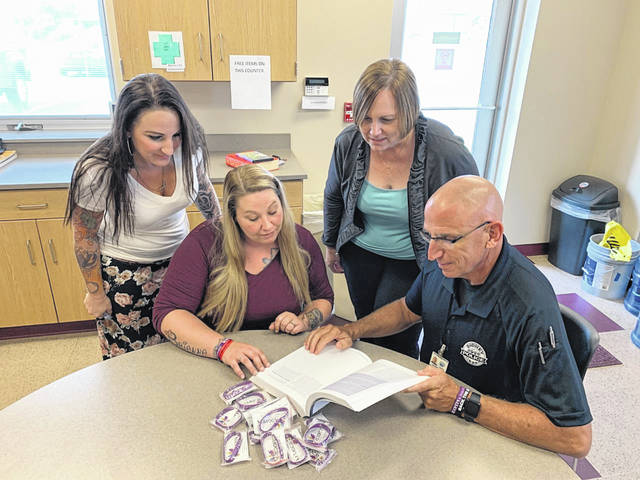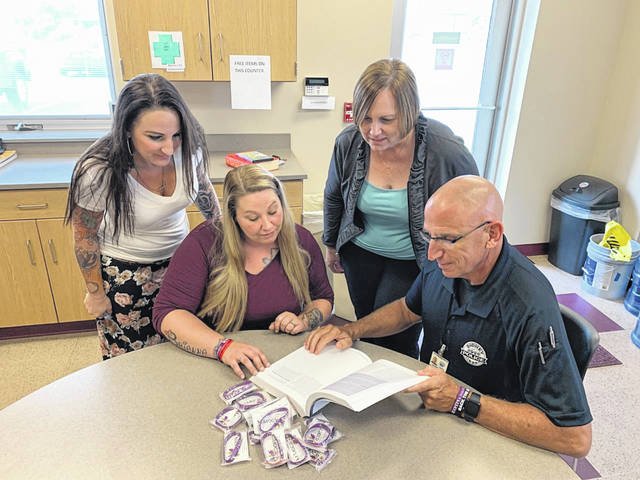

SIDNEY — The Sidney Police Department (SPD) was recently awarded a $25,000 grant by the Ohio Attorney General’s Office to combat drug abuse.
Police Chief Will Balling said the grant was dispersed in September. Grant funds will allow retired Officer Mike McRill to return to SPD on a part time basis. His first day back as the SAAT (Sidney Addict Assistance Team) coordinator was Sept. 23.
A similar, previous grant was awarded to Sidney Police in 2017 to fight the opioid epidemic and drug abuse. The $50,000 grant was dispersed over two years ending in June 2019.
“This grant will be good for one year,” Balling said. “And part of that grant money will be able to provide Mike’s services to our community. And we are also going to be trying to work with the counseling center to get counseling services available to people who need it.”
The Ohio Attorney General’s Office awarded 40 law enforcement departments in 2017 $3 million in grant money to help expand drug abuse teams (DARTs) and quick response teams (QRTs) to address the opioid epidemic in Ohio.
SPD’s version of these programs is called SAAT and is run by McRill. SAAT’s purpose is to reach out to those who have overdosed from opioids to help them get treatment. The program, which was modeled after the Colerain Township Police Department’s program, was instituted within the SDP in 2016.
McRill retired from full time work at the SPD a year ago, but has continued to work at the department at least eight hours a month as a reserve officer.
After retiring, McRill begun working for the Montgomery County Alcohol Drug Addiction & Mental Health Services (ADAMHS) three days a week. His work at ADAMHS focuses on mental health and training officers and first responders how to reach out and interact with someone who is struggling with mental health issues, as well as struggling co-workers.
Now he will return two days a week with SPD. In his role as SAAT coordinator, Balling said, McRill will be continuing to work as a reserve officer with full police authority, participate in ongoing training, and be a go-between among officers, dispatchers, other law enforcement agencies and various programs and councilors.
“I see those two jobs as very much intertwined. Because you are working with people who are struggling with something beyond their ability to cope. Whether it is addiction, or mental health,” McRill said. “Whether they are someone suffering from addiction, or dealing with a friend, co-worker, or a law officer you encounter somewhere else. Because of the stuff they are exposed to on the job, they are struggling.”
He joked with a chuckle, “So as my wife said, ‘So, you are back to full time. I thought you were retiring for a reason.’”
“Mike established (SAAT) first on his own (prior to the 2017 grant). Capt. (Jerry) Tangeman and Officer McRill went to Colerain Police Department and started learning about this and said ‘Let’s bring this here.’ Mike was the team at the very beginning,” Balling said.
“ — And then the chief found a grant and got me some friends (to build a SAAT team),” McRill continued with a smile.
“It was something that we all saw, at that time with the opioids, of just that feeling that, ‘hey, we’ve got to do something different. This isn’t a good situation. People are dying,’” McRill said of how SAAT came about. “That goes back to 2016.”
The Sidney Department of Fire and Emergency Services reports in 2016 there were 100 overdose incidents in Sidney, during which 171 doses of Naloxone were used. And then 2017 started off with a very high number of overdoses, but its trajectory went up and down over the course of the year. Sidney’s first responders administered a total of 306 doses of Naloxone during 144 incidents to 123 patients that year in Sidney. The numbers have gone down since 2017, with 154 doses of Naloxone during 80 incidents to 64 patients in 2018 in Sidney. And through the end of September of this year, first responders have administered a total of 82 doses of Naloxone during 49 incidents to 43 patients in Sidney.
Opioid use is down, but methamphetamine use is on the rise, Balling and McRill acknowledged.
Balling and McRill said there have been six deaths connected with Shelby County since April of this year, which are suspected to be drug-related.
“That was part of the reason Chief and I had talked about that and looking into re-upping the grant. Because even though it sound great the numbers are down. That’s awesome. — Unless that’s your family. Then you don’t care about the numbers. You care about the one,” McRill said.
“(The numbers) are down, but they are still there. Like Mike said, we are not seeing it where squads, or officers are running out every single day with it. We do see a lot more methamphetamines (now) too. But the opioids there, we are still seeing a loss of life from it. — Even six from it,” Balling said. “When you think of a community like Sidney or Shelby County, we have a homicide about every 18 months, but if you consider the overdose death, if we have six to 10 a year, that’s a quiet substantial number of lives lost.”
Typically, police respond to an overdose and know that person needs help, but with meth, there is not necessarily a tip-off for McRill to know who needs help.
“(The SAAT team) always talked about the idea, and I have no official documentation or evidence-based research to support it, but the idea of continued connection or relentless relationship. In other words, the expanding the team and allowing us to tracking of all the information, allowed us to set a pattern, where we would meet with someone the first time, usually after an overdose. And we would have four contacts over a six-month period at 45, 90 and 180 days. That was the pattern,” McRill said of how he approaches his work with opioid users.
“The people that are on meth, we don’t get a call on an overdose situation, that a person is down, I don’t believe. But they are also very difficult to talk to,” McRill said of learning how to address the rising meth situation.
He noted people who are in and out of the system, may have pending theft charges, are known to law enforcement, possibly don’t have a driver’s license or job, and are difficult to have a focused conversation with are some of the signs that attract law enforcement’s attention.
The grant only funds a coordinator, but other team members either volunteers their time or is provided from the Family Resource Center of Northwest Ohio in the Sidney Office (formerly Shelby County Counseling). McRill said he notices people the team works with looks to him for a fatherly influence or a law enforcement perspective. Former SAAT grant coordinator and current SPD civilian evidence coordinator Becky Drinnen, who volunteers her time, often offers a motherly influence, he said. Drug and alcohol councilors Kim Moreth and Cassie Davis at Family Resource Center provides a counseling perspective to those in need.
“The goal is to bring recognition that the (SAAT) program is back and running full strength and that Officer McRill and his team are up and running, so it gives people an avenue,” Balling said.


